Sample information |
|
| Picture |
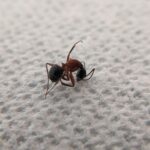
|
|---|---|
| Location | |
| Collection date | 08/30/2020 |
| Captive / Cultivated? | Wild-caught |
| Group | Bordenstein Lab |
| Observations | This medium sized ant was crawling across a paved walking trail. It was moving so fast that I was unable to capture a live action picture. It was collected by placing a collection vial over top and allowing it to climb up. The ant has a black head, amber-colored thorax and legs, and a black abdomen. It was collected at 11:45am. 78F, 85% humidity, slightly cloudy. |
| Putative identification | Arthropoda Insecta Hymenoptera Formicidae Camponotus Camponotus chromaiodes |
Methods |
|
| Extraction kit | DNeasy (Qiagen) |
| DNA extraction location | Abdomen |
| Single or Duplex PCR | Single Reaction |
| Gel electrophoresis system | MiniOne |
| Buffer | TBE |
| DNA stain | |
| Gel images |
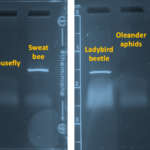
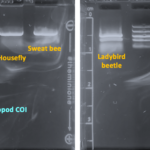
|
| Protocol notes | The ant was stored in 70% ethanol at room temperature for about 3 weeks prior to DNA extraction. DNA Extraction: The ant was incubated in lysis buffer at 56C for 2 hours. Because there was cell debris, I did a 30 sec spin and transferred the supernatant to a fresh tube of 200ul ethanol. This was placed in the freezer overnight and DNA was purified the following day. Eluted DNA was immediately incubated at 65C for one hour prior to PCR. PCR: MiniOne Taq polymerase was used. Gel electrophoresis: The arthropod gel looks whispy; however, that went away as the gel ran longer. This could have been caused by not adding loading dye to samples. The results were very clear, though. I re-colored the gel images in PowerPoint. The MiniOne ladder contains 5 bands: 100, 300, 500, 1000, and 2000 bp. |
Results |
|
| Wolbachia presence | Yes |
| Confidence level | High |
| Explanation of confidence level | The DNA extraction was successful because the arthropod COI amplified. Both (+) and (-) controls worked. The Wolbachia 16S rRNA band was present. Sanger sequencing was successful for both templates. It is a Rust colored carpenter ant (Camponotus chromaiodes) infected with Supergroup A-Wolbachia. |
| Wolbachia 16S sequence | Download FASTA
Download AB1
TGGCTGTCGTCAGCTCGTGTCGTGAGATGTTGGGTTAAGTCCCGCAACGAGCGCAACCCTCATCCTTAGTTACCATCAGGTAATGCTGGGGACTTTAAGGAAACTGCCAGTGATAAACTGGAGGAAGGTGGGGATGATGTCAAGTCATCATGGCCCTTATGGAGTGGGCTACACACGTGCTACAATGGTGGCTACAATGGGCTGCAAAGTCGCGAGGCTAAGCTAATCCCTTAAAAGCCATCTCAGTTCGGATTGTACTCTGCAACTCGAGTGCATGAAGTTGGAATCGCTAGTAATCGTGGATCAGCACGCCACGGTGAATACGTTCTCGGGTCTTGTACACACTGCCCGTCACGCCATGGGAATTG
BLAST at The Wolbachia Project BLAST at NCBI
|
| Arthropod COI sequence | Download FASTA
Download AB1
AGTTGGCTCCTCTATAAGAATAATCATTCGACTAGAGTTGGGATCTCCTGATTCACTAATTCTTAATGATCAAACTTTCAATACCATCGTTACAAGTCATGCTTTTATTATAATTTTTTTTATAGTTATACCTTTTATAATTGGGGGATTTGGTAATTTTTTAATTCCCCTTATACTAGGATCTCCTGATATAGCTTACCCCCGTTTAAATAACATAAGATTTTGATTACTTCCCCCATCGATCTCCTTATTAATCCTAAGAAATTTTATTAATGAAGGATCTGGAACTGGTTGGACTGTCTACCCCCCTCTATCATCAAATACCTTCCATAGTGGCCCCTCTATTGACCTGACTATCTTTTCTCTCCATATTGCTGGTATATCCTCAATTATAGGAGCAATCAATTTTATTTCAACAATTATAAATATACATAATTCCAATATTTCCCTAGATAAAATTCCCTTATTAGTATGGTCTATTCTTATTACAGCTATTCTCCTTCTTCTGTCCCTACCTGTTCTAGCAGGAGCTATTACAATACTACTAACAGACCGAAATCTTAATACTTCATTTTTCGACCCTTCGGGAGGGGGAGA
BLAST at The Wolbachia Project BLAST at NCBI
|
| Summary | The Camponotus chromaiodes was found to be postive for Wolbachia. |
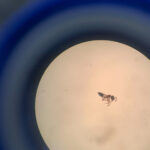 Ant
Ant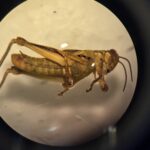 Differential Grasshopper – Melanoplus differentialis
Differential Grasshopper – Melanoplus differentialis Pill Bug (Armadillidium vulgare) – Draft
Pill Bug (Armadillidium vulgare) – Draft Melanoplus Femurrubrum
Melanoplus Femurrubrum Grasshopper – Orthoptera
Grasshopper – Orthoptera